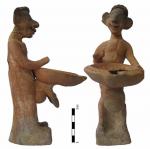Summary (English)
HERACLEA SINTICA (Lyudmil Vagalinski – lvagalin@techno-link.com, Ivo Cholakov) A fortification wall, 2.10 m wide and built of uneven stones bonded with mortar, with levelling courses of fragmentary building ceramics and stone slabs, was explored on site No. 1. Its foundation is 50 cm deep. The wall is preserved up to 1.80 m in height. A section of the wall, 13.50 m long, was discovered. According to the coins, the fortification wall was constructed after the 1st century AD and before AD 257. A burned house, which was built of uneven stones with a bonding medium of mud, was explored. The occupation strata are c. 3.50 m in thickness. The occupation strata on site No. 2 are also c. 3.50 m thick, but reach up to 4.50 m in thickness. A production facility of the 4th century BC – 6th century AD was explored in 1958. In 2007, its chronology was specified. The production facility was set to fire during the first half of the 3rd century AD. Terracotta figurines were produced during the second occupation period. Basins, buildings constructed of uneven stones and dried bricks with roofs covered with tiles, a street, a catch-water drain and dolia were discovered. The production facility was set on fire after AD 270. The production of terracotta figurines continued during the third occupation period. A catch-water drain, a supporting wall, 1 m wide and preserved up to 4.50 m in height, and barrel-vaulted rooms were constructed. The production facility was set on fire at the end of the 3rd century AD. The production of terracotta figurines stopped during the fourth occupation period. A fire dated after AD 383 was registered. No materials dated after the 4th century AD were found. The finds include 94 bronze and silver coins from the 4th century BC to 4th century AD, terracotta figurines, terracotta moulds for producing terracotta figurines, two small votive reliefs showing Artemis and Heracles, terracotta lamps, ceramic vessels, loom weights, iron tools, bronze jewellery, bones of pigs, goats, sheep, horses, donkeys, ox, hens, dogs, foxes, rabbits and wild pigs.
Director
- Ivo Cholakov - Archaeological Institute with Museum
- Lyudmil Vagalinski - Archaeological Institute with Museum
Team
Research Body
- Archaeological Institute with Museum






![Download [PDF]](/excavation/skins/fasti/images/results/download_sml.png)